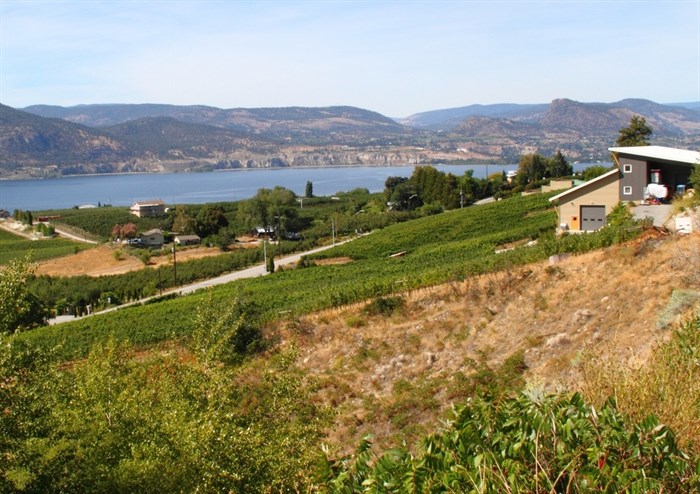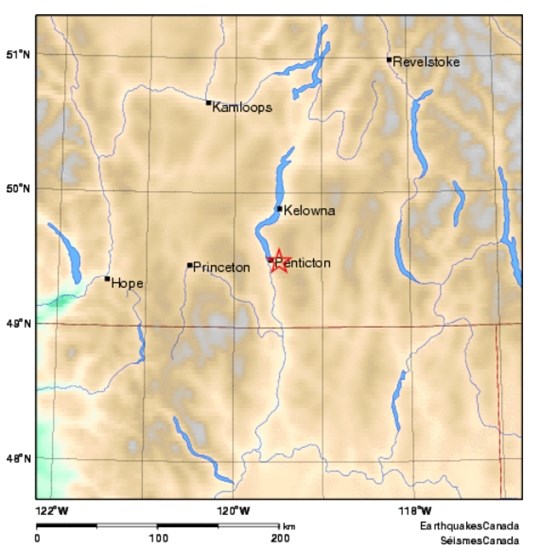
Vineyards in Naramata are pictured in this file photo. The small earthquake in the South Okanagan yesterday startled a number of people in Penticton and Naramata, but not to worry, seismologists say, it wasn’t a harbinger of the "big one".
Image Credit: Wikimedia Commons/Agne27
June 19, 2015 - 2:41 PM
PENTICTON - The small earthquake in the South Okanagan yesterday startled a number of people in Penticton and Naramata, but not to worry, seismologists say, it wasn’t a harbinger of the "big one".
The shallow depth, magnitude 2.5 quake took place at 4:45:02 p.m., Thursday, June 18, “almost directly under Penticton, just to the southeast,” Geological Survey of Canada seismologist Alison Bird says.
Bird says people reported hearing a loud rumble “like a truck going by” and noticed a “bump” beforehand.
“That’s pretty much the way everyone describes an earthquake of that size,” she says.
Bird says the Penticton area has been prone to events similar to yesterday’s quake, noting all recorded quakes within 10 kilometres of the city have been under magnitude 3. While she says an earthquake in the Penticton area wouldn’t likely cause damage, “it’s not impossible” for a larger quake to occur some day.
University of British Columbia’s Department of Earth, Ocean and Atmospheric Sciences seismologist Dr. Michael Bostock says the Okanagan Valley lies on an ancient fault line which has not been tectonically active since the Oligocene period — 23 million years ago — although it still represents a zone of weakness as a fault zone.
One of the reasons for Thursday’s quake could be stress transfer from movement of the Juan de Fuca and North American plates colliding off the B.C. coast, he says. Those stresses can transfer through several hundred kilometres of the continental plate into the Okanagan Valley.

Approximate location of an earthquake lightly felt in Penticton and Naramata, Thursday, June 18, 2015.
Image Credit: Natural Resources Canada
Bostock also noted the Okanagan Valley was extensively glaciated 10,000 years ago. The weight of that mass of ice compressed the earth it covered, and even today, the earth is adjusting through “isostatic rebound,” another form of stress on the earth which might cause sudden movement in zones of weakness.
“The Okanagan is not typically earthquake prone. It’s generally a fairly quiet region,” Bostock says.
Historically, the largest quake known to have occurred in the Okanagan area took place in 1872 south of the border near Lake Chelan in Washington State. Seismologists estimate that quake had a magnitude 7.3 based on damage descriptions made at the time. Damage from that quake was noticed as far north as Keremeos where a museum archival account describes an early settler who lived near the Grist Mill saying the earth opening up and swallowing several pigs.
In Canada, Bostock said a magnitude 6 earthquake was recorded near Valemount, B.C. in 1918 and more recently a magnitude 5.5 quake shook Prince George in 1986.
Bostock says it is interesting to note some relatively large quakes have occurred in eastern Canada between Ottawa and Quebec City due to an ancient fault zone which runs through the Ottawa Valley.
For more information on earthquakes, including a national map depicting earthquake locations over the past 30 days go to the Natural Resources Canada website.
To contact the reporter for this story, email Steve Arstad at sarstad@infonews.ca or call 250-488-3065. To contact the editor, email mjones@infonews.ca or call 250-718-2724.
News from © iNFOnews, 2015